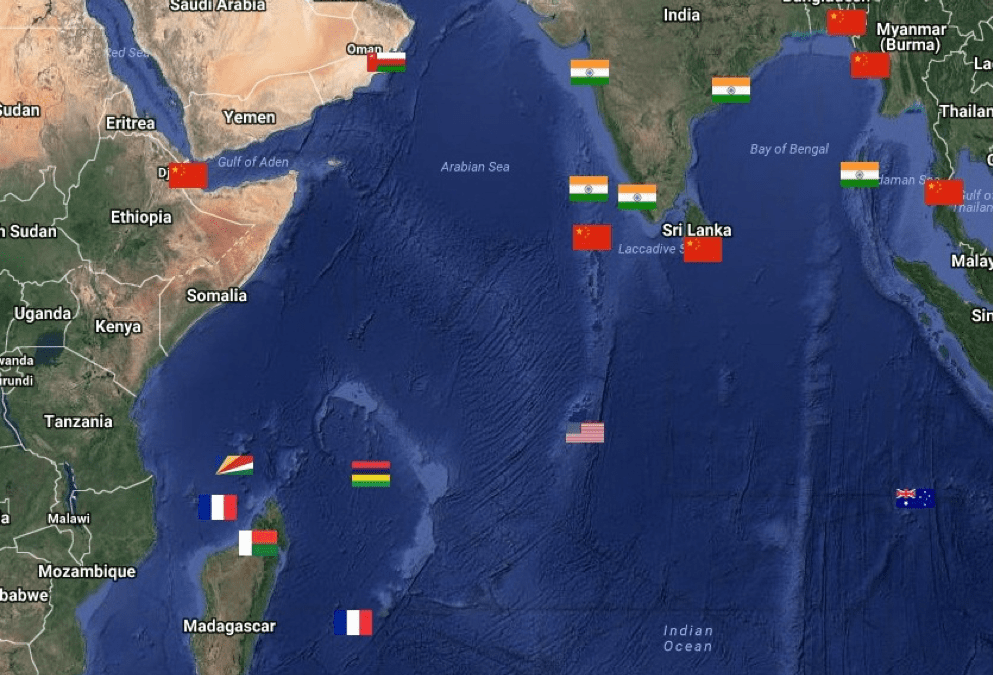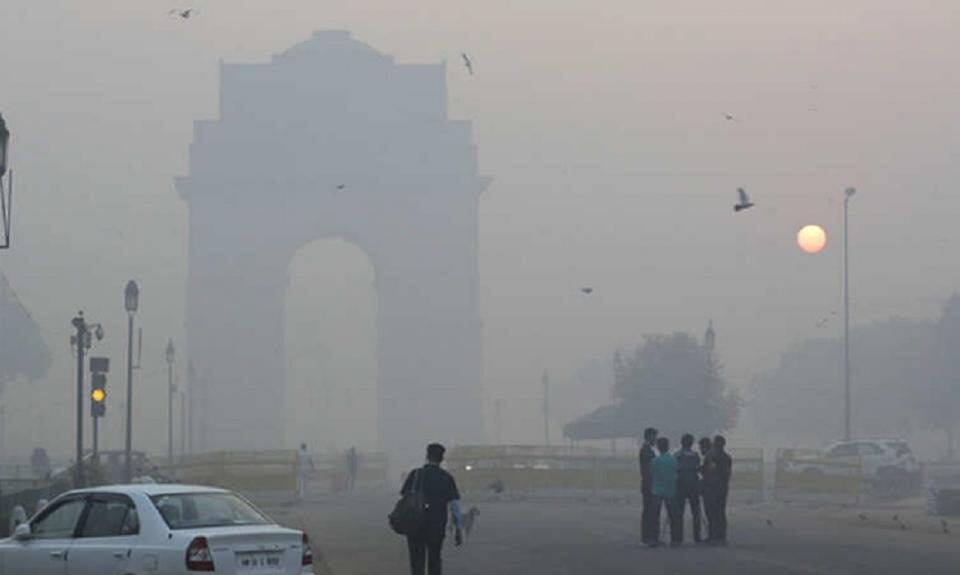
Iqbal’s Legacy: A Lens for Understanding Palestinian Resilience
November 13, 2023
Parallels in Unresolved Conflicts
November 15, 2023
Akif Ali Hayat
The Indian Ocean is of paramount importance in global trade, serving as a vital maritime gateway, connecting states and economies. It plays a pivotal role in the global supply chain as it hosts important chokepoints such as the Suez Canal, Strait of Malacca, and Strait of Hormuz which are crucial for the movement of goods across oceans. China, being the “world’s factory”, depends on these maritime trade routes for the movement of its goods. China is increasing its influence in the Indian Ocean to ensure economic and energy security, geopolitical interests, and project power, all in alignment with its economic and strategic objectives.
China is contending with challenges to its economic interests, energy security, and its strategic position in the Indian Ocean region. Firstly, China finds itself confronted with the strategic challenge known as the “Malacca Dilemma”. It poses a formidable challenge to both trade and energy security. According to the United Nations Conference on Trade and Development (UNCTAD), in 2019, approximately 80% of China’s oil imports and over 35% of its total containerized trade by volume passed through the Strait of Malacca. China’s trade with the Indian Ocean Region is over $900 billion, the majority of it passes through the Strait of Malacca. [1]
Secondly, China’s Maritime Silk Route, the second component of its BRI, confronts various challenges. The primary objective of this initiative is to establish connectivity between China’s coastal cities and the Pacific and Indian Ocean regions. This ambitious infrastructure project encompasses the creation of maritime shipping routes that traverse the South China Sea and the Indian Ocean, thereby linking China to key regions including South Asia, the Middle East, Africa, and Europe. Given their pivotal role in facilitating global trade, commerce, and connectivity, the security and stability of these sea lanes of communication and shipping routes become a subject of paramount importance. Lastly, the “Necklace of Diamonds” strategy employed by India represents a noteworthy aspect of its foreign policy. India’s positioning at the center of the United States’ Indo-Pacific strategy and its active participation as a member of the Quadrilateral Security Dialogue (QUAD) is contributing to a complex dynamic in the Indian Ocean region. This strategy involves the encirclement of China through cooperative alliances and engagements with various countries, creating challenges that China confronts within the Indian Ocean.
China has strategically addressed its energy security concerns by adopting a multifaceted approach, which includes diversifying its energy supplies. A key element of this strategy involves importing energy resources from Central Asia, a region rich in hydrocarbons. China has established extensive energy infrastructure and trade networks, such as the China-Central Asia gas pipelines, to facilitate the transportation of oil and natural gas from countries like Kazakhstan and Turkmenistan. [2] Further, the China-Pakistan Economic Corridor (CPEC) serves as a vital component of China’s efforts to reduce its dependence on the Strait of Malacca. Through CPEC, China seeks to establish alternative routes for the transportation of goods and energy resources, not only by circumventing the congested strait but also by linking Gwadar Port in Pakistan with China’s northwestern region. [3] These strategic initiatives reflect China’s commitment to enhancing its energy security and reducing vulnerabilities associated with critical chokepoints in the global energy supply chain.
Militarily, China deployed a nuclear submarine in the Indian Ocean in 2013 and conducted a satellite-tracking ship visit to Hambantota, Sri Lanka, in 2022, along with establishing a naval base in Djibouti in 2017. [4] China has also solidified its presence through agreements for military access to ports in nations such as Bangladesh, Myanmar, Pakistan, and Sri Lanka, accompanied by joint military exercises with host countries. Furthermore, China’s undersea intelligence-gathering and surveying operations reveal its intent to develop offensive and counteroffensive capabilities, securing its trade routes and preventing potential sea-based interdictions. [5] These strategic military endeavors underscore China’s unwavering commitment to augmenting its influence and presence in the Indian Ocean region, signaling a pivotal development in the geopolitics of the area.
Economically, China’s approach, often accompanied by “checkbook diplomacy”, is evident in a range of initiatives. The China-Pakistan Economic Corridor (CPEC) is a prime example, involving significant infrastructure development and the Gwadar Port in Pakistan, which not only provides alternate trade pathways but also solidifies China’s presence through the luring effect of substantial investments. Concurrently, China’s involvement in Sri Lanka’s Hambantota Port and Myanmar’s Kyaukpyu Special Economic Zone strategically positions the nation along major trade corridors, exemplifying the fusion of economic investments and diplomatic maneuvering. [6] Similarly, China’s engagement in the development of Chittagong Port in Bangladesh further extends its regional sway. These endeavors, coupled with engagements in the Maldives, Seychelles, and Mauritius, underscore China’s economic-driven approach in the Indian Ocean region, expanding its footprint, intensifying connectivity, and advancing its strategic interests in a region that has gained growing geopolitical significance.
Diplomatically, Beijing has strategically enhanced China’s standing in multinational forums within the Indian Ocean region (IOR) by skillfully engaging secondary powers and island nations. China has established a longstanding relationship with Pakistan due to shared enmity with India, while also becoming Bangladesh’s principal supplier of military hardware and textiles. Moreover, China has actively engaged with four IOR island nations—Sri Lanka, Maldives, Mauritius, and Seychelles—that are strategically situated along China’s maritime trade routes. For instance, China serves as Sri Lanka’s largest export destination and a significant military hardware provider. These engagements are marked by numerous high-level visits and post-BRI commitments, signifying the growing importance of these nations as China’s “new natural partners.” Through a combination of hard and soft power tactics, China has effectively strengthened its influence in regional organizations like the Indian Ocean Rim Association (IORA) and the Indian Ocean Commission (COI), utilizing financial incentives to bolster its diplomatic and military maneuvering capabilities in the IOR.
The escalation of China’s influence in the Indian Ocean has significant implications for the region. First and foremost, it alters the geopolitical landscape by challenging the traditional dominance of regional players, potentially leading to increased tensions. China’s military expansion and strategic assets, including naval bases and agreements for military access, raise security concerns among neighboring countries, contributing to a potential arms race. Economically, China’s infrastructure projects may boost regional development but also create debt traps, limiting the economic sovereignty of host nations. Moreover, China’s growing role in multinational forums may reshape the dynamics of regional organizations, potentially sidelining the interests of other stakeholders.
All in all, China’s increasing influence in the Indian Ocean is driven by its strategic efforts to ensure economic and energy security, geopolitical interests, and project power in alignment with its broader objectives. This multifaceted strategy encompasses economic investments, military presence, and diplomatic engagements. The implications include potential shifts in regional power dynamics, heightened security concerns, and the need for a nuanced approach to balance engagement with China and safeguarding regional interests.
References
[1] “Crude Petroleum in China,” Observatory of Economic Complexity, 2021, https://oec.world/en/profile/bilateral-product/crude-petroleum/reporter/chn.
[2] Aizhu, Chen, and Marat Gurt. “China Prioritizing Turkmenistan over Russia in Next Big Pipeline Project.” Reuters, May 24, 2023.
[3] Fazl-e-Haider, Syed. “A Strategic Seaport – Is Pakistan Key to China’s Energy Supremacy?” Foreign Affairs, March 5, 2015. Archived from the original on April 18, 2015.
[4] David Brewster, ed., India and China at Sea: Competition for Naval Dominance in the Indian Ocean, 1st edition (New Delhi: Oxford University Press, 2018), 113–15.
[5] Frédéric Grare and Jean-Loup Samaan, The Indian Ocean as a New Political and Security Region (Cham, Switzerland: Palgrave Macmillan, 2022), 23.
[6] Thiha, Amara. “Xi’s Upcoming Visit to Myanmar Could Reshape the Indian Ocean Region.” The Diplomat, January 4, 2020
The writer is a student of International Relations at the National University of Modern Language, Rawalpindi. She tweets @akifali100khans.







